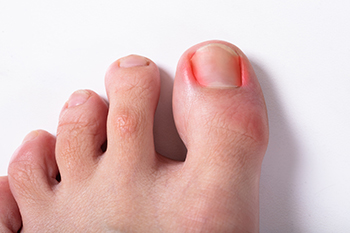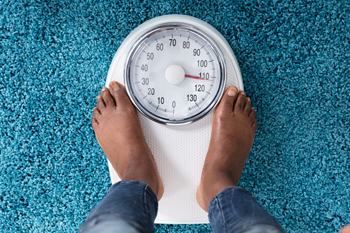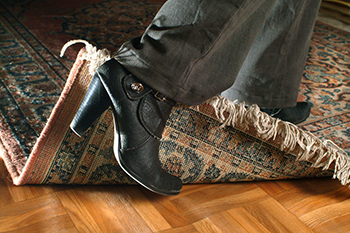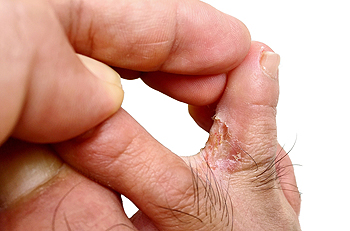Items filtered by date: July 2022
Causes and Treatment for Ingrown Toenails

One of the most painful, not to mention annoying, skin irritations is an ingrown toenail. It is simply the result of the nail, commonly on the big toe, growing into the skin that surrounds it. Ingrown toenails can be the result of cutting the nails too short, or, ironically, by letting them grow too long. Nails that are ripped or torn, or nails that are cut into a rounded shape, also can cause ingrown toenails. They cause pain and sometimes redness, especially if the toes are encased in shoes that are too tight in the toe box. Improperly fitting shoes, along with toe injuries, and repetitive activity are among other causes of ingrown toenails. Cutting toenails straight across and soaking the feet in a salt-water bath a few times a day can help to relieve the pain. However if the ingrown toenail pain increases, becomes warm to the touch, or if there is a buildup of pus and an unpleasant odor, it may be infected. This would be a good time to consult with a podiatrist for immediate treatment.
Ingrown toenails can become painful if they are not treated properly. For more information about ingrown toenails, contact Dr. Steven Sheridan of Ankle & Foot Specialty Clinics. Our doctor can provide the care you need to keep you pain-free and on your feet.
Ingrown Toenails
Ingrown toenails occur when a toenail grows sideways into the bed of the nail, causing pain, swelling, and possibly infection.
Causes
- Bacterial infections
- Improper nail cutting such as cutting it too short or not straight across
- Trauma to the toe, such as stubbing, which causes the nail to grow back irregularly
- Ill-fitting shoes that bunch the toes too close together
- Genetic predisposition
Prevention
Because ingrown toenails are not something found outside of shoe-wearing cultures, going barefoot as often as possible will decrease the likeliness of developing ingrown toenails. Wearing proper fitting shoes and using proper cutting techniques will also help decrease your risk of developing ingrown toenails.
Treatment
Ingrown toenails are a very treatable foot condition. In minor cases, soaking the affected area in salt or antibacterial soaps will not only help with the ingrown nail itself, but also help prevent any infections from occurring. In more severe cases, surgery is an option. In either case, speaking to your podiatrist about this condition will help you get a better understanding of specific treatment options that are right for you.
If you have any questions please feel free to contact our office located in Sandusky, MI . We offer the newest diagnostic and treatment technologies for all your foot and ankle needs.
The Link Between Obesity and Foot Pain

Just like any other medical disease or condition, foot pain is associated with several risk factors. This is to say that carrying a certain attribute makes one more likely to suffer from foot pain. For instance, pregnant women and arthritic individuals are at a higher risk of experiencing foot pain. One often overlooked high risk group is obese individuals. Once one’s body mass index has increased, the incidence of plantar heel pain increased. Likewise, fat mass is positively correlated with foot pain. Obese individuals are also more likely to have flat feet as well. This is likely the case because obese people place more weight and force down onto their feet, pushing down any natural arch so that the entire foot lays flush against the ground. If you are obese, you can reach out to a podiatrist to assist you with any foot pain you might have.
Obesity has become very problematic at this point in time and can have extremely negative effects on the feet. If you’re an obese individual and are concerned about your feet, contact Dr. Steven Sheridan from Ankle & Foot Specialty Clinics. Our doctor can provide the care you need to keep you pain-free and on your feet.
Obesity and Your Feet
Since your feet are what support your entire weight when standing, any additional weight can result in pain and swelling. Being overweight is one of the main contributors to foot complications.
Problems & Complications
Extra Weight – Even putting on just a few extra pounds could create serious complications for your feet. As your weight increases, your balance and body will shift, creating new stresses on your feet. This uneven weight distribution can cause pain, even while doing the simplest tasks, such as walking.
Diabetes – People who are overweight are at serious risk of developing type-2 diabetes, which has a drastic impact on the health of your feet. As you get older, your diabetes might worsen, which could lead to loss of feeling in your feet, sores, and bruises. You could also become more prone to various infections.
Plantar fasciitis – Pressure and stress that is placed on muscles, joints, and tendons can trigger plantar fasciitis, which is an inflammation of tissue that forms along the bottom of the foot.
If you have any questions please feel free to contact our office located in Sandusky, MI . We offer the newest diagnostic and treatment technologies for all your foot and ankle needs.
Ways Seniors Can Prevent Falls at Home

The risk of falling at home increases after reaching the age of 65. This can be caused by diminished balance, strength, and eyesight. Other causes may be dizzying effects from certain medications and neuropathy problems that affect the feet. Further, if you fall once, you are far more likely to fall again, unless changes are made around the house. The majority of home falls take place in the bathroom, experts say. Some preventative measures include installing grab bars in the bath and shower area, putting a chair in the bathing area, and adding non-slip strips or a mat on the tub floor. Other parts of the home can also be modified to decrease the likelihood of a fall. Remove throw rugs, declutter passageways, and add lighting in darker areas, especially stairs and long hallways. Keep a clear path to the bathroom to increase your safety at night. Make sure you use handrails or a walking device if dizziness or balance issues are a problem. Wear shoes with non-skid soles, and avoid going barefoot. If you need more information on preventing falls, please contact a podiatrist who can offer suggestions to help keep you upright.
Preventing falls among the elderly is very important. If you are older and have fallen or fear that you are prone to falling, consult with Dr. Steven Sheridan from Ankle & Foot Specialty Clinics. Our doctor will assess your condition and provide you with quality advice and care.
Every 11 seconds, an elderly American is being treated in an emergency room for a fall related injury. Falls are the leading cause of head and hip injuries for those 65 and older. Due to decreases in strength, balance, senses, and lack of awareness, elderly persons are very susceptible to falling. Thankfully, there are a number of things older persons can do to prevent falls.
How to Prevent Falls
Some effective methods that older persons can do to prevent falls include:
- Enrolling in strength and balance exercise program to increase balance and strength
- Periodically having your sight and hearing checked
- Discuss any medications you have with a doctor to see if it increases the risk of falling
- Clearing the house of falling hazards and installing devices like grab bars and railings
- Utilizing a walker or cane
- Wearing shoes that provide good support and cushioning
- Talking to family members about falling and increasing awareness
Falling can be a traumatic and embarrassing experience for elderly persons; this can make them less willing to leave the house, and less willing to talk to someone about their fears of falling. Doing such things, however, will increase the likelihood of tripping or losing one’s balance. Knowing the causes of falling and how to prevent them is the best way to mitigate the risk of serious injury.
If you have any questions, please feel free to contact our office located in Sandusky, MI . We offer the newest diagnostic and treatment technologies for all your foot care needs.
Gout Pain Can Be Managed
Uncomfortable Athlete’s Foot

Fungus causes athlete’s foot which is contagious and can be an uncomfortable and unsightly foot condition. Many people get athlete’s foot from warm and moist environments including public swimming pools, shower room floors, and locker rooms. The fungus can enter the feet through small cracks in the skin and can produce red and itchy areas on the feet. It may be more prevalent among people who sweat profusely or those who wear shoes and socks consistently causing the feet to lack air. A common location of athlete’s foot is between the toes and on the bottom of the feet. Additional symptoms include dry, scaly skin and blisters may develop in severe cases. The toenails are often affected causing toenail fungus. The chances of full recovery can improve when this foot condition is immediately treated. If you have symptoms of athlete’s foot, it is strongly suggested that you are under the care of a podiatrist who can effectively treat this condition.
Athlete’s Foot
Athlete’s foot is often an uncomfortable condition to experience. Thankfully, podiatrists specialize in treating athlete’s foot and offer the best treatment options. If you have any questions about athlete’s foot, consult with Dr. Steven Sheridan from Ankle & Foot Specialty Clinics. Our doctor will assess your condition and provide you with quality treatment.
What Is Athlete’s Foot?
Tinea pedis, more commonly known as athlete’s foot, is a non-serious and common fungal infection of the foot. Athlete’s foot is contagious and can be contracted by touching someone who has it or infected surfaces. The most common places contaminated by it are public showers, locker rooms, and swimming pools. Once contracted, it grows on feet that are left inside moist, dark, and warm shoes and socks.
Prevention
The most effective ways to prevent athlete’s foot include:
- Thoroughly washing and drying feet
- Avoid going barefoot in locker rooms and public showers
- Using shower shoes in public showers
- Wearing socks that allow the feet to breathe
- Changing socks and shoes frequently if you sweat a lot
Symptoms
Athlete’s foot initially occurs as a rash between the toes. However, if left undiagnosed, it can spread to the sides and bottom of the feet, toenails, and if touched by hand, the hands themselves. Symptoms include:
- Redness
- Burning
- Itching
- Scaly and peeling skin
Diagnosis and Treatment
Diagnosis is quick and easy. Skin samples will be taken and either viewed under a microscope or sent to a lab for testing. Sometimes, a podiatrist can diagnose it based on simply looking at it. Once confirmed, treatment options include oral and topical antifungal medications.
If you have any questions, please feel free to contact our office located in Sandusky, MI . We offer the newest diagnostic and treatment technologies for all your foot care needs.

